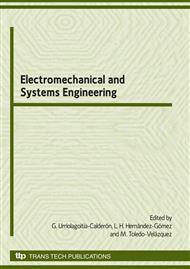[1]
M. Madou: Fundamentals of Microfabrication, Second edition, (2002).
Google Scholar
[2]
J. Chiou and Y. Lin: A multiple electrostatic electrodes torsion micromirror device with linear stepping angle effect, Journal of Microelectromechanical Systems, vol. 12, pp.913-920, (2003).
DOI: 10.1109/jmems.2003.820287
Google Scholar
[3]
G. Rinaldi, M. Packirisamy, and I. Stiharu: Geometrical Performance Conditioning of Microstructures, International Conference on Smart Materials Structures And Systems, pp.191-198, (2005).
Google Scholar
[4]
T. Hirano, T. Furuhata, K. J. Gabriel and H. Fujita: Design, Fabrication, and Operation of Submicron Gap Comb Drive Microactuators, Journal of Micro Electro Mechanical Systems, vol. 1, pp.52-59, (1992).
DOI: 10.1109/84.128056
Google Scholar
[5]
P. Muthukumaran, I. Stiharu, and R. B. Bhat: Boundary conditioning of capacitive MEMS devices through fabrication methods and operating environments, Proceedings of ISSS-SPIE 2002/SD-406, (2002).
DOI: 10.1117/12.514940
Google Scholar
[6]
M. Packirisamy: Microfabrication influence on the behavior of capacitive MEMS sensors and actuators, Sensor Review, 26/1, pp.58-65, (2006).
DOI: 10.1108/02602280610640698
Google Scholar
[7]
P. Muthukumaran, R. Bhat, and I. Stiharu: Boundary Conditioning Technique For Structural Tuning, Journal of Sound and Vibration, vol. 220, pp.847-859, (1999).
DOI: 10.1006/jsvi.1998.1991
Google Scholar
[8]
W. Sharpe, B. Yuan, R. Vaidyanathan, R. Edwards: Measurements of Young Modulus, Poisson Ratio, and Tensile Strength of Polysilicon, Micro Electro Mechanical Systems, MEMS 97, Proceedings, IEEE, (1997).
DOI: 10.1109/memsys.1997.581881
Google Scholar
[9]
G. Staffan, E. Fredric, J. Stefan, F. Matthias and R. Arnold, Mechanical characterization of thick polysilicon films: Young's modulus and fracture strength evaluated with microstructures, J. Micromech. Microeng., 9 pp.245-251, (1999).
DOI: 10.1088/0960-1317/9/3/305
Google Scholar
[10]
S. Bhat, R. Fernandez, S. Stolyarova and E. Bhattacharya: Resonance frequency and young's modulus of composite porous silicon/silicon cantilever beams, 8th. World Congress on Computational Mechanics, Venice, Italy, (2008).
Google Scholar
[11]
T. Namazu, Y. Isono, T. Tanaka: Evaluation of size effect on mechanical properties of singlecrystal silicon by nanoscale bending test using AFM, Journal of Microelectromechanical Systems, Volume 9, Issue 4, Dec (2000) pp.450-459.
DOI: 10.1109/84.896765
Google Scholar
[12]
O. Holmgren, K. Kokkonen, and T. Veijola: Analysis of vibration modes in a micromechanical square-plate resonator, Journal of Micromechanics and Microengineering 19, 015028 p.11, (2009).
DOI: 10.1088/0960-1317/19/1/015028
Google Scholar
[13]
K. Krupa, M. Jozwik, C. Gorecki, A. Andrei, Ł. Nieradko, P. Delobelle, L. Hirsinger: Static and Dynamic Characterization of Al9-Driven Microcantilevers Using Optical Interference Microscopy, Optics and Lasers In Engineering, 47, pp.211-216, (2009).
DOI: 10.1016/j.optlaseng.2008.05.001
Google Scholar
[14]
L. Dong-chan, C. Hyeun-seok , H. Chang-soo, J. Hee-jun: A Compensation of Young's Modulus In Polysilicon Structure with Discontinuous Material Distribution", Materials Letters, 59, pp.3900-3903, (2005).
DOI: 10.1016/j.matlet.2005.07.040
Google Scholar
[15]
C Liang and B. C. Prorok: Measuring the Thin Film Elastic Modulus with A Magnetostrictive Sensor, Journal of Micromechanics and Microengineering, 17, 709- 716, (2007).
DOI: 10.1088/0960-1317/17/4/006
Google Scholar
[16]
A. Ballestra, E. Brusa, M. Munteanu, A. Soma: Experimental characterization of electrostatically actuated in-plane bending of microcantilevers, Microsystems Technology 14, pp.909-918, (2008).
DOI: 10.1007/s00542-008-0597-0
Google Scholar
[17]
M. Shamshirsaz, M. Bahrami, M. ASGARI and M. Tayefeh: Analysis of Polysilicon Micro Beams Buckling with Temperature Dependent Properties, DTIP of MEMS and MOEMS, Stressa, Italy, (2007).
DOI: 10.1142/s1465876303001356
Google Scholar


